
Thomasia quercifolia, commonly known as oak leaved thomasia, is a flowering plant in the family Malvaceae and is endemic to the south-west of Western Australia. It has egg-shaped, lobed leaves with a heart-shaped base, and pink to mauve flowers.
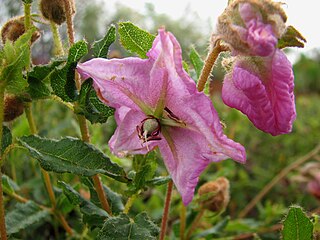
Thomasia grandiflora, commonly known as large-flowered thomasia, is endemic to the south-west of Western Australia. The flowers are pinkish-purple with a papery appearance hanging in pendents from the leaf axils. The calyx lobes are prominent and larger than the petals.
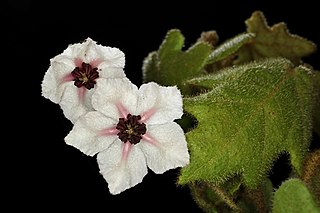
Thomasia solanacea is a species of flowering plant in the family Malvaceae and is endemic to the south-west of Western Australia. It is an erect, bushy shrub with egg-shaped leaves, the bases heart-shaped, and racemes of white, cream-coloured or pink to purple flowers.

Seringia velutina, commonly known as velvet firebush, is a species of flowering plant in the family Malvaceae family and is endemic to the south-west of Western Australia. It is a suckering shrub that sometimes forms dense colonies. Its leaves are narrowly elliptic to egg-shaped and it has 3 to 11 pale pink to purple flowers arranged in loose cymes.

Calytrix angulata, commonly known as yellow starflower, is a species of flowering plant in the myrtle family Myrtaceae and is endemic to the south-west of Western Australia. It is a shrub with linear to egg-shaped leaves and clusters of yellowish-cream coloured flowers with 30 to 40 yellow stamens in several rows.

Conospermum densiflorum, commonly known as crown smokebush, is a species of flowering plant in the family Proteaceae and is endemic to the south-west of Western Australia. It is an erect, much-branched shrub with thread-like leaves at the base of the plant, and spikes or corymbs of velvety, cream-coloured or blue, tube-shaped flowers.

Lasiopetalum glutinosum is a species of flowering plant in the family Malvaceae and is endemic to the south-west of Western Australia. It is a spreading, multi-stemmed shrub with densely hairy young stems, egg-shaped leaves often with three lobes and bright pink or dark red flowers.
Lasiopetalum laxiflorum is a species of flowering plant in the family Malvaceae and is endemic to the south-west of Western Australia. It is a sticky, straggling subshrub or shrub with many densely hairy stems, egg-shaped leaves, and bright pink and dark red flowers.
Lasiopetalum monticola is a species of flowering plant in the family Malvaceae and is endemic to the south-west of Western Australia. It is an erect, slender or straggling shrub with densely hairy branchlets, leaves and flowers, egg-shaped leaves and pink, cream-coloured or white flowers.
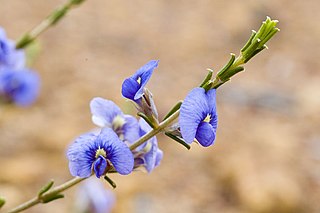
Mirbelia floribunda, commonly known as purple mirbelia, is a species of flowering plant in the family Fabaceae and is endemic to the south-west of Western Australia. It is an erect, slender or straggling, much-branched shrub with narrowly linear leaves and bluish-purple flowers.
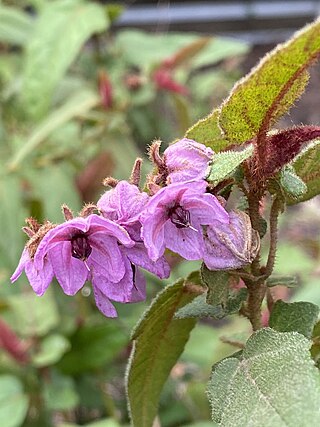
Thomasia paniculata is a species of flowering plant in the family Malvaceae and is endemic to the south-west of Western Australia. It is a spreading shrub with heart-shaped to narrowly egg-shaped leaves and pinkish-mauve flowers.
Thomasia discolor is a species of flowering plant in the family Malvaceae and is endemic to the south-west of Western Australia. It is a small, compact shrub with hairy new growth, heart-shaped leaves with wavy, lobed edges, and pink flowers in crowded clusters.

Thomasia discolor is a species of flowering plant in the family Malvaceae and is endemic to the south-west of Western Australia. It is a multi-stemmed shrub with densely hairy branchlets, coarsely serrated, egg-shaped leaves with a heart-shaped base, and many small pink, cream-coloured or white flowers.
Thomasia × formosa is a species of flowering plant in the family Malvaceae and is endemic to a restricted area of the south-west of Western Australia. It is an erect, compact shrub with densely hairy branchlets, hairy, coarsely serrated, egg-shaped to elliptic or oblong leaves, and racemes of pink or purple flowers arranged in leaf axils.
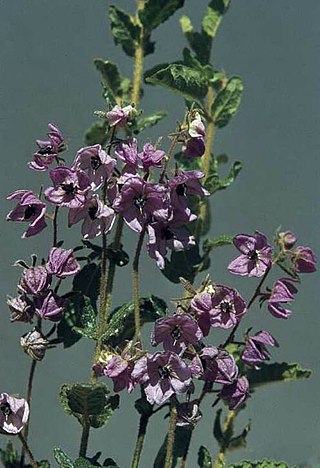
Thomasia macrocalyx is a species of flowering plant in the family Malvaceae and is endemic to the south-west of Western Australia. It is an erect, bushy shrub with densely hairy new growth, egg-shaped leaves with a heart-shaped base and lobed or toothed edges, and groups of pale purple to mauve or white flowers.

Thomasia rhynchocarpa is a species of flowering plant in the family Malvaceae and is endemic to the Southwest Australia south-west of Western Australia. It is an erect, slender shrub with narrowly egg-shaped leaves with a heart-shaped base, and pink to purple flowers.
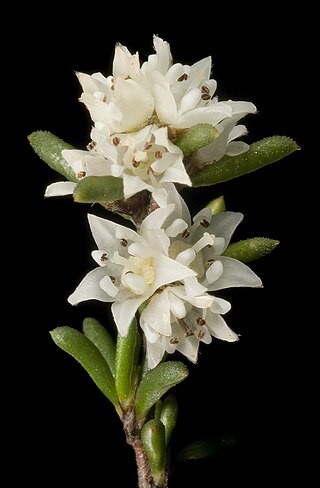
Cryptandra myriantha is a flowering plant in the family Rhamnaceae and is endemic to southern continental Australia. It is a slender, erect or straggling shrub with cylindrical leaves and more or less sessile clusters of creamy-white to pink flowers.
Commersonia corylifolia, commonly known as hazel-leaved rulingia, is a species of flowering plant in the family Malvaceae and endemic to the southwest of Western Australia. It is a spreading, erect shrub with egg-shaped to narrowly egg-shaped leaves, and white to cream-coloured flowers.

Guichenotia micrantha, commonly known as small flowered guichenotia, is a species of flowering plant in the family Malvaceae and is endemic to the south-west of Western Australia. It is a low, compact shrub with linear to narrowly egg-shaped leaves and pink flowers in groups of three to six.
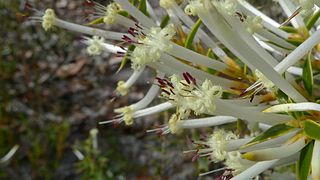
Styphelia tenuiflora, commonly known as common pinheath, is a species of flowering plant in the heath family Ericaceae and is endemic to the south-west of Western Australia. It is an erect shrub with broadly egg-shaped to lance-shaped leaves and whitish-cream, tube-shaped flowers with hairy lobes.

















